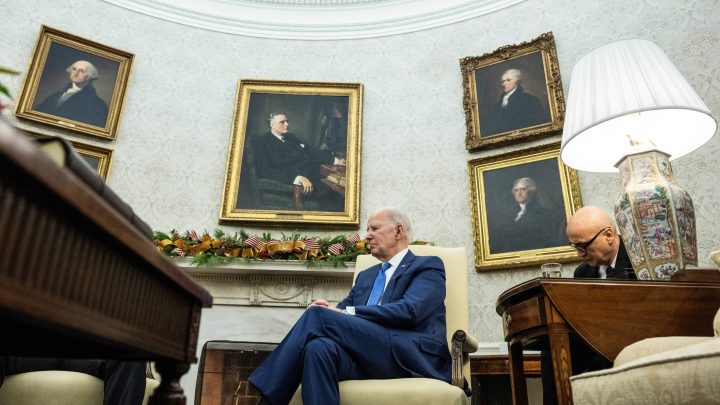
FDR’s New Deal transformed the economy. Could Biden do the same?
FDR’s New Deal transformed the economy. Could Biden do the same?

Congress has authorized over $1 trillion in spending through the Inflation Reduction Act, CHIPS and Science Act and Bipartisan Infrastructure Law. In a new series called “Breaking Ground,” “Marketplace” host Kai Ryssdal will be visiting communities across the country to look at how this infusion of federal dollars might change the economy — in complicated, invisible, even contradictory ways.
On the first episode of the series, Ryssdal explores the legacy of the New Deal as a before-and-after moment for the U.S. economy. Because whether we realize it or not, the era we’re living through could be a before-and-after moment too.
Click the audio player above to hear the full episode.
The New Deal in American life today
Across from a high school in Inglewood, California, there is a 240-foot-long petrachrome mural depicting the history of transportation, from walking to air travel.
“It may also be the largest petrachrome mural in the world,” said Natalie McDonald, a graduate student in history at California State University, Northridge, and research assistant for the Living New Deal, a history project based at the University of California, Berkeley, that chronicles the legacy of the New Deal.

This mural was paid for by the Works Progress Administration — a government agency created by Franklin D. Roosevelt’s administration as part of his effort to stimulate the economy during the Great Depression.
“The New Deal was comprehensive and wide-ranging” McDonald said. In addition to investing in roads, bridges, dams and other infrastructure, the U.S. government under the New Deal launched a range of social programs, hired out-of-work writers and actors through the Federal Theatre Project, and commissioned public artwork across the country.
“[The New Deal] was all about investing in the democratic future of the country, improving the daily lives of ordinary Americans in as many ways as possible,” McDonald said. “And that included our creative lives.”
How we got there
When Franklin Delano Roosevelt was first inaugurated as president in 1933, he was facing “a nation on the brink,” said Jason Scott Smith, a history professor at the University of New Mexico and author of two books about the New Deal era. It was the height of the Great Depression, unemployment was near 25% and banks across the country were failing.
“So of course, Roosevelt comes into office, he calls the Congress into emergency session, and we have the famous first 100 days,” Smith said.
In FDR’s first 100 days as president, Congress passed a historic number of bills trying to stabilize the economy. This included the creation of the Federal Deposit Insurance Corp. to assure Americans their savings were safe in banks, as well as a series of public works programs.
A 1959 documentary called “Life in the Thirties” shows archival footage of 1930s government workers constructing power poles, hauling logged trees and working to prevent soil erosion.
“Men are going to work for the government by the millions on new buildings, roads, schools, bridges — anything to get the ‘forgotten man,’ as Roosevelt calls him, off the bread lines and on the job, any job,” the narrator says.
The Public Works Administration, created by the National Industrial Recovery Act in 1933, received a $3.3 billion appropriation.

“At the time, that was 165% of federal revenues,” Smith said. “So that’s an enormous investment in public works construction relative to the size of the federal government, relative to the size of the American economy. Something like that had never been tried on such a scale before.”
Beyond any individual program or investment, the New Deal marked a historic shift in how the government interacted with the economy and the people living in it. It was a before-and-after moment.
“The federal government is a player in a way that never had been before,” Smith said. Before the New Deal, Americans typically dealt with the federal government only when they went to the post office, Smith noted.
“After the New Deal, Americans are interacting with the federal government in an almost daily sort of way,” Smith said. “Taxes withheld from their paycheck to fund Social Security, federal deposit bank insurance. [There are] all of these ways that Americans are encountering a social safety net, a kind of welfare state that did not exist before.”
“The New Deal is kind of the biggest peacetime growth of government in American history,” said Price Fishback, professor of economics at the University of Arizona.
There’s a lot happening in the world. Through it all, Marketplace is here for you.
You rely on Marketplace to break down the world’s events and tell you how it affects you in a fact-based, approachable way. We rely on your financial support to keep making that possible.
Your donation today powers the independent journalism that you rely on. For just $5/month, you can help sustain Marketplace so we can keep reporting on the things that matter to you.


















